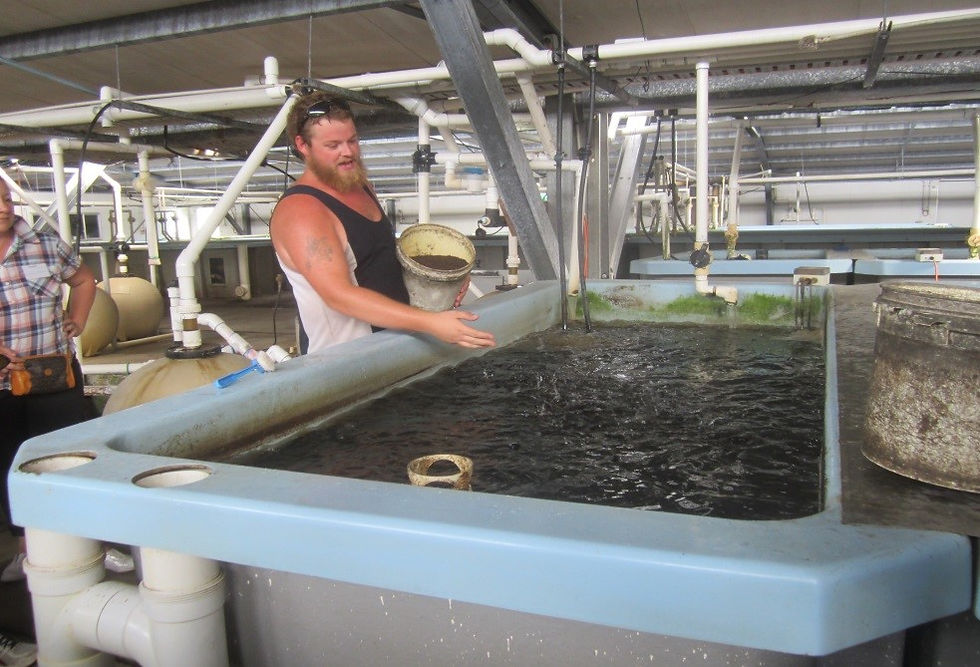Barramundi Fish Farm
- Barbara Nudd
- Mar 9, 2018
- 4 min read
Each year Hunter Organic Growers pays for a workshop or tour for members to attend. The Barramundi Fish Farm was the 2018 choice, and was well attended by members and visitors.
14 of us arrived for lunch at the Fish Farm's restaurant "COOKABARRA" where we greatly enjoyed a selection of barramundi dishes, created from the fish from the farm. We were greatly impressed by the presentation of Brett's (Limestone Permaculture) Thai Barramundi. It was served thickly crusted with a seasoning mix, standing longways on the plate. Very spectacular!

Nick Arena, who conducted our tour, started the farm 20 years ago. He obtained the first licence on the eastern seaboard to farm barramundi and his is still the only licence for this along the coast. Some of the conditions for the licence are that the farm must be more than 500 metres from the waterway and his tanks must be 2.5 metres above the flood line.

Nick Arena discussing the filtration system with HOGS members

A licence is required to pump bore water which he uses for his fish grow tanks. He draws water from 90 feet, which results in a pH closer to the 7.2 that is needed for fish health and growth. It can be supplemented with bicarb soda to raise the pH. At 30 feet deep his bore gives water with a pH of 6.5, resulting in higher costs for bicarb soda.
Antibiotics are very rarely required. Increasing the salt content usually fixes most problems.
Nick buys in fingerlings, which are more cost effective than breeding his own stock, the fingerlings arrive every 2 months, and take 9 months to grow to the preferred selling size of 600 grams up to 1 kg.
Barramundi are carnivores, and when farmed, are fed on high protein fishmeal pellets. The fish will not eat dead fish, so the pellets are made to float, imitating the normal diet of grasshoppers, moths, small fish etc. The larger fish are fed the pellets 2 times a day, and 3 times a day for smaller nursery fish. At 5 months old the nursery fish are released into larger tanks. The food conversion to grow to 1kg of fish is 1.2kg’s of food required. To save money, Nick purchases 10 tonne of feed at a time, with the landed cost being $2.50 per kilogram.

All of Nick's fish tanks are in a large temperature-controlled building. He has solar heating, and considerable electricity bills. The fish grow best at temperatures of 29⁰C to 42⁰C. They will survive down to 17⁰C, but do not grow.
Keeping the water in the tanks well filtered is crucial to fish health. Nick has a 3 stage filter system: the first removed the large debris, the second is a bio filter, and the third is a vacuum system/ backwash which keeps the filters clear .

As the fish occasionally eat each other, they are moved from tank to tank to keep sizes similar. When it is time to harvest, ½ of the water from the tank is pumped to the tank in the delivery truck so that the conditions are the same. A few drops of oil of cloves is introduced to the water of the fish tanks to calm the fish. The fish can then be weighed and then moved to the tank in the delivery truck, and as they are calm, the process goes quickly and safely for the fish. (They take about 10 minutes to wake up again). Scoop boxes have bars set at different size gaps (like a coin sorting machine) to ensure that the fish harvested are the right size. Nick sends 80% of his fish to Sydney and the other 20% are currently served in the restaurant on-site.
We learnt a lot! Here are a few extra interesting facts:
- At present in Australia, only 30% of barramundi sold is Australian, and 70% is imported.
- Barramundi all start off as males, and turn into females when they are large enough. In the wild, this is usually around 6 years of age.
- In the demonstration tanks in the restaurant complex there are some very large barramundi, the oldest is 10 years old. Can you see the white barramundi?

- During their life in the wild, they move between fresh and salt water. Depending on where they are caught – river or sea, the flavour of wild caught barramundi varies greatly – the seawater fish will have a much cleaner flavour.
- The fish in the ponds around the restaurant are Barcoo grunters, also known as jade perch. In winter, trout replace them. Perch are frequently farmed elsewhere, but are more expensive to grow to 1 kg size than barramundi, as they take longer than the barramundi's 9 months.
- Nick reports a hydroponic system uses 18 litres of water to grow 1 kg of tomatoes, compared to 120 litres if grown in the ground. Lettuce use approximately 8 litres to produce 1 head. The hydroponic system pumps the used water back to the top of the plant grow-pipes to be re-used.
A great day. Many thanks to Nick Arena for a very interesting tour, to the restaurant staff for a great meal, and to HOGS for paying for the tour.





























